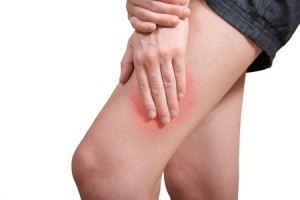Oh, My Aching…Leg?
NASA Area Chiropractor Comments: Certain low back conditions give rise to more than just low back pain. For example, leg pain can be more intense than low back pain, even though the cause of the leg pain is coming from the low back. When this happens, many patients complain that they have “sciatica,” which refers to radiating pain that starts in the low back and extends down into the leg. When the intensity of leg pain is worse than the low back, it can make patients wonder, “…where is my problem really coming from?”

To understand this better, a short “anatomy lesson” is appropriate. The spine can be divided into two halves, front and back. The structures in the front half include the larger, heavier bones called vertebral bodies and the shock absorbing cushions that lie between the vertebral bodies called the intervertebral disks. The disk is like a jelly donut where the center is liquid-like and the outer portion is a tough, criss-cross pattern cartilage arranged like the rings on a tree stump. There are also ligaments that hold the vertebrae and disks tightly together. The back half of the spine includes the spinal cord, nerve roots, as well as the small joints of the back called facet joints. Every movable joint has a joint capsule that helps lubricate the joint and limits the amount of movement, along with surrounding ligaments. The larger, heavier vertebral bodies and shock absorbing disks carry the majority of the weight (approximately 80%) while the smaller facet joints carry much less weight (only 20%) but are more responsible for guiding the movements of our back.
When leg pain is present, it can be caused by either a pinched nerve, or, an inflamed facet joint.
When a nerve is pinched, the cause is usually from the intervertebral disk where the jelly-like center leaks out and presses on the nerve that goes down the leg, commonly referred to as a “herniated disk with sciatica.” This type of pain is quite specific, easy to describe and often extends below the knee to the ankle or foot. It can include muscle weakness, numbness in certain areas of the leg, and bending forward increases low back and leg pain while bending backwards reduces the leg pain (and sometimes the LBP).
When a facet joint capsule tears (technically, called a “sprain”), the pain is “referred” down the leg in a generalized, non-specific manner, usually described as a “deep ache,” often hard to describe and usually does not go below the level of the knee. Here, it feels better to bend forward and worse to bend backwards, of which neither movement changes or affects the leg in a specific way. Disk related leg pain carries a potential for surgery if all non-surgical approaches fail, while facet joint referred leg pain rarely requires invasive treatments or surgery.
The good news is that both of these sources of low back and leg pain are very treatable with chiropractic care! The important point to remember is that obtaining prompt treatment, when symptoms first appear is best – as waiting and hoping it will subside on its own often results in a longer treatment course and is less satisfying for all concerned.
Dr. Ward Beecher practices at Beecher Chiropractic Clinic at 1001 Pineloch, Ste 700 Houston, TX 77062. You can schedule an appointment at BeecherChiropractic.com or by calling (281) 286-1300. If you have any questions regarding this blog, please comment below!
Sciatica
To download a copy of this newsletter, please click here.
Sciatica
Houston Chiropractor Comments: The term sciatica describes the symptoms of leg pain—and possibly numbness, tingling or weakness—that originate in the lower back and travel through the buttock and down the large sciatic nerve in the back of the leg. It is a common complaint, with more than 3 million cases a year being reported.
- The large sciatic nerve is irritated or compressed in the lumbar spine.
- Sciatica is often characterized by one or a combination of the following symptoms.
- Constant pain in only one side of the buttock or leg (rarely can occur in both legs).
- Pain that is worse when sitting
- Leg pain that is often described as burning, tingling or searing (vs. a dull ache)
- Weakness, numbness or difficulty moving the leg or foot.
- A sharp pain that may make it difficult to stand up or to walk.
Sciatica type pain is usually caused by 6 main conditions. These conditions are lumbar herniated disc, degenerative disc disease, spondylolisthesis, lumbar spinal stenosis, piriformis syndrome and sacroiliac joint dysfunction.
Sciatica is typically self –limiting and will resolve itself with ice, stretching and light exercise. On cases that last more than 72 hours (3 days) the assistance of a doctor or trained therapist is beneficial. Conservative care is the most beneficial except in cases with loss of bowel or bladder function. Chiropractic care with spinal manipulation has been shown to have excellent results. Physical modalities can be added to assist in reducing the muscle spasms and inflammation. After the sciatica is resolved, a good stretching and strengthening program for the back is beneficial to help prevent a reoccurrence. If you have issues with your sciatica in Houston TX call me now.
Dr. Ward Beecher practices at Beecher Chiropractic Clinic at 1001 Pineloch, Ste 700 Houston, TX 77062. You can schedule an appointment at BeecherChiropractic.com or by calling (281) 286-1300. If you have any questions regarding this blog, please comment below!


